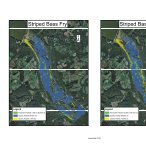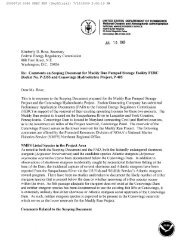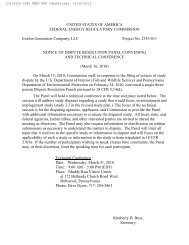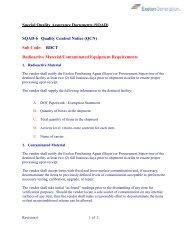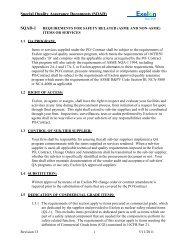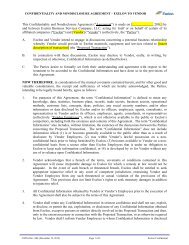Final Report Historical Structures Assessment Report for the Muddy ...
Final Report Historical Structures Assessment Report for the Muddy ...
Final Report Historical Structures Assessment Report for the Muddy ...
You also want an ePaper? Increase the reach of your titles
YUMPU automatically turns print PDFs into web optimized ePapers that Google loves.
Historic <strong>Structures</strong> <strong>Assessment</strong> <strong>Report</strong> <strong>for</strong> <strong>the</strong> <strong>Muddy</strong> Run Pumped Storage Facility Project Relicensing Application<br />
Lancaster and York Counties, Pennsylvania<br />
The Modern Era (1900 to Present)<br />
In <strong>the</strong> early twentieth century, creameries were a significant element of Lancaster’s agricultural economy.<br />
In 1916 <strong>the</strong>re were 40 creameries in <strong>the</strong> county. One of <strong>the</strong> biggest, Farmer’s Creamery, was located in<br />
Drumore Township (Roddy 1916). Agricultural land use continued into <strong>the</strong> twentieth century; in 1960,<br />
Lancaster County was <strong>the</strong> largest farming county in Pennsylvania with 4,650 farms (Stevens 1964:345).<br />
In comparison, York County had 2,700 farms, a little more than half of those in Lancaster County<br />
(Stevens 1964:345).<br />
The Columbia & Port Deposit Railroad was <strong>the</strong> principal route <strong>for</strong> moving freight between points on <strong>the</strong><br />
Pennsylvania Main Line and points on <strong>the</strong> Philadelphia, Baltimore, and Washington line. Freight trains<br />
were more efficiently and economically operated through <strong>the</strong> low grade of <strong>the</strong> Lower Susquehanna Valley<br />
ra<strong>the</strong>r than <strong>the</strong> heavier grades used <strong>for</strong> through passenger service (Burgess and Kennedy 1949:375). The<br />
Columbia & Port Deposit Railroad was relocated to higher ground from Conestoga Creek Bridge to Safe<br />
Harbor in 1905–1906 because of construction of <strong>the</strong> Holtwood Dam and <strong>the</strong> resulting lake.<br />
In 1916, <strong>the</strong> Columbia & Port Deposit Railroad and o<strong>the</strong>r lines consolidated into <strong>the</strong> Philadelphia,<br />
Baltimore, & Washington Railroad Company, a subsidiary of <strong>the</strong> Pennsylvania Railroad Company<br />
(Burgess and Kennedy 1949:375–376; 554). The railroad was relocated between Port Deposit and Fite’s<br />
Eddy in 1926–1928, when <strong>the</strong> Conowingo Dam was built. The railroad was electrified in 1938 and <strong>the</strong>n<br />
de-electrified in <strong>the</strong> early 1980s. It is still in active service today and owned by <strong>the</strong> Norfolk/Sou<strong>the</strong>rn<br />
Corporation (Smith 1997; Trower 2002).<br />
Hydroelectric power production facilities were developed beginning in <strong>the</strong> early 1900s to take advantage<br />
of <strong>the</strong> Susquehanna River’s <strong>for</strong>ce. In 1904, <strong>the</strong> York Haven Hydroelectric Station, located at Conewago<br />
Falls, was opened (Sheets 1991:210). The Holtwood Power Plant, which began operation in 1910, was <strong>the</strong><br />
largest producer of electricity at <strong>the</strong> time and is still a major producer of electricity <strong>for</strong> south central<br />
Pennsylvania (Synder and Boyle 1984). By 1916, <strong>the</strong>re were nine hydroelectric plants in Lancaster<br />
County (Roddy 1916). The massive Conowingo Dam was built near Darlington, Maryland a short<br />
distance downstream of <strong>the</strong> Project between 1926 and 1928 to provide hydroelectric power to supply<br />
Philadelphia and sou<strong>the</strong>astern Pennsylvania with electricity. (Lower Susquehanna Heritage Greenway<br />
2006; MHT Determination of Eligibility (DOE) Form, US 1 over Susquehanna River/Conowingo Dam,<br />
HA-1971).<br />
Electricity from <strong>the</strong> Conowingo plant also powered railroad lines between New York and Washington,<br />
D.C., and was used <strong>for</strong> industrial and residential applications. When constructed, Conowingo Dam was<br />
<strong>the</strong> second largest hydroelectric development in <strong>the</strong> United Sates after Niagara Falls (Camden County<br />
Vocationalite, June 1930). It was and still is <strong>the</strong> single largest generation station to be built in one step,<br />
and used <strong>the</strong> most up-to-date technology, as well as <strong>the</strong> largest turbines and generators ever produced<br />
(Maryland Humanities Council 2001:259; Jefferson et al 2007). It is “apparently <strong>the</strong> first dam, of major<br />
size, built entirely by chuting concrete” and reportedly <strong>the</strong> longest slab dam in <strong>the</strong> United States<br />
(Maryland State Highway Administration 1997:463).<br />
Since <strong>the</strong> end of World War II, <strong>the</strong> Lancaster and York County areas have developed several residential<br />
communities. Farmland has declined, population has grown (and continues to grow), and <strong>the</strong> landscape<br />
has became more suburban in nature. A recently renewed interest in <strong>the</strong> region's past has led to physical<br />
and historical revitalization of <strong>the</strong> area. In <strong>the</strong> 1960s, an agreement was passed among Maryland,<br />
Pennsylvania, and New York to begin work on clearing <strong>the</strong> Susquehanna River of sewage, coal-mining<br />
seepage, soil runoff, and chemical fertilizers. At <strong>the</strong> same time, a movement was also taking shape to<br />
clean up <strong>the</strong> Chesapeake Bay.<br />
15





